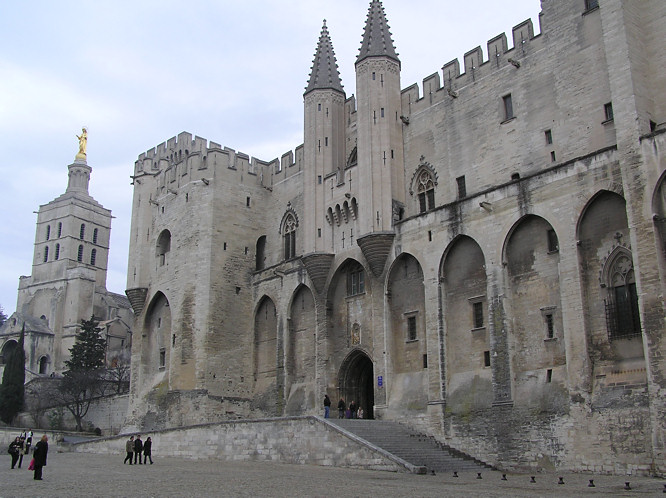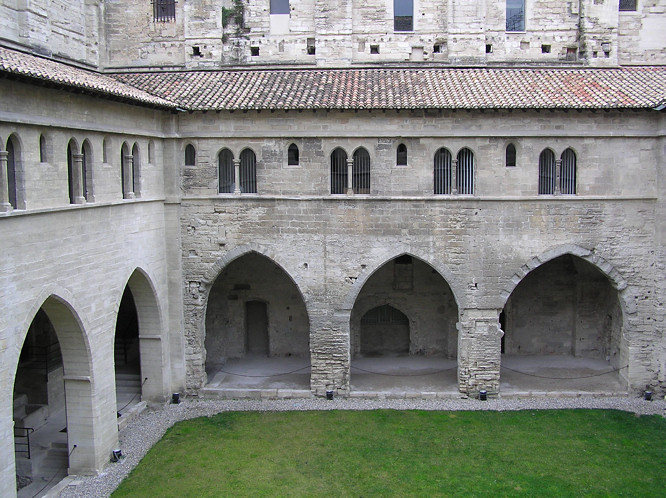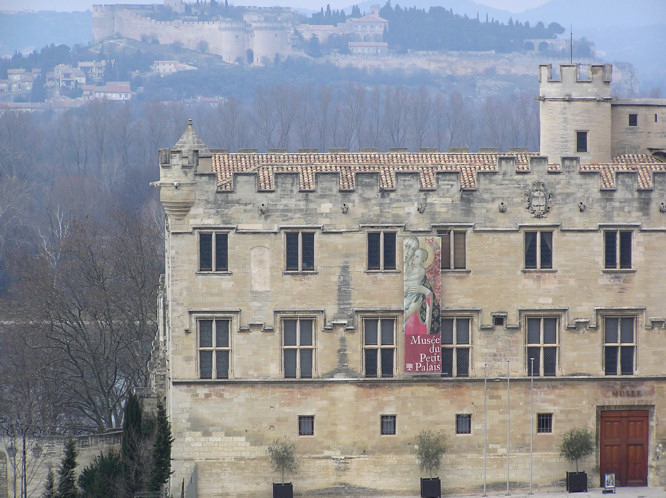Avignon Palace of the Popes - Palais des Papes
The first thing you notice about this great palace of the popes is that it is more fortress-like appearance than a fairy-tail palace. When the Pope moved back to his home city of Avignon he was in trouble and needed somewhere safe to stay.

It was meant to protect the Pope. He was guarded by a military garrison of mercenary Swiss Guards. It became the seat of the Roman Catholic church. It was the 'Great Schism' that forced the popes to flee Roman and stay in Avignon France. Also called the Western Schism or Papal Schism it was a split in the Roman Catholic Church from 1378 to 1417.
There were two men in each political camp who claimed to be the true Pope at the same time. This split was political rather that theological. It hurt the reputation of the Papal Office. What is now modern France, Scotland, Sothern Italy and Spain supported the Pope in Avignon. Northern Italy, Britain, Ireland, Flanders, Hungary, Poland and Scandinavia supported the Pope in Rome. The Church in Avignon was seen as under control of the French King.

It is a major tourist attraction and very popular during the summer high season. Most people only associate the Vatican in Rome with the Pope. It is not commonly known that nine Popes lived in Avignon Palais des Papes palace of the Popes. It is very impressive and is a must for anyone visiting Avignon. Outside the Palace is a very large square. On the opposite side to the palace you will find cafes and restaurants with tables and chairs outside. It is a wonderful location to have something to eat and drink to soak up the atmosphere and watch the world go by.
In the 1304, Pope Clement V moved to Avignon Palais des Papes palace of the Popes for his personal security. He was due to go to Rome for his consecration. It wasn't until 1377 that Pope Gregory XI moved back to Rome 73 years later. The Church retained control of this palace but with the pope gone this huge building complex became neglected. At times it was used as a prison.
In the beginning when the Pope first moved in the Papal court used the Palais Episcopal, which existed on the site before Pope Benoit XII ordered the construction of a new palace in 1334. Le Palais des Papes was constructed in two stages. The older part is now referred to as Palais Vieux the old Palace. The newer part was built twenty years later. It is called Palais Neuf the new palace.

During the French Revolution, the palace was ransacked by local mobs. Unfortunately much of the original furniture and artwork was destroyed or stolen. In 1810 the Napoleonic French army converted it into barracks.
But in 1969, the city of Avignon began to restore the palace. It is now a museum and has been listed as a world heritage site by the UNESCO. Although most of the palace rooms and chambers are empty, it is not hard to imagine the grandeur of the place during its heyday in the 14th Century. Make sure you look out for the wonderful frescoes from the mid 14th Century still visible on the walls. The audio guide is available in different languages. It helps you get a better understanding of the history of the building.
It is the largest Gothic Palace in Europe. There are over 25 rooms and great halls open to the public. It is suggested that you allocate between 3 - 4 hours for your visit. We are comfortable shoes as there are lots of stairs and corridors to cover. Disability access is very limited. It is worth while buying a combined discounted entrance fee to both the Papal Palace and the Bridge of Avignon.
The Small Palace - Petit Palais
At the far end of the Square of the Popes' Palace, the elegant silhouette of the Petit Palais creates a counterpoint to its imposing neighbour. It was the palace of the archbishops of Avignon. With Pope John XXII living in the former archbishops' palace, his nephew Arnaud de Via began the construction of a new episcopal palace in 1314. The facade, in renaissance style, dates from the end of the 15th century; it was done by the archbishop of Avignon, Julien de la Rovere, the future Julius II, warrior pope and patron of the Arts, who was one of the great names of the Renaissance
Le musee du Petit Palais
Near the Palace des Papes square has an outstanding collection of Italian and Provencal paintings from the 13th century to the beginning of 16th century as well as Roman and Gothic sculpture. It is open all week apart from Tuesday. From June to September in the summer season it opens it's doors 10am to 6pm. The rest of the year it closes for an hour for lunch at 1pm and reopens at 2pm.
Travel books

